


Let us begin with the general problem of adding up the contributions from many sources of radiation in the Universe in such a way as to arrive at their combined intensity as received by us in the Milky Way (Fig. 2). To begin with, we take the sources to be ordinary galaxies, but the formalism is general. Consider a single galaxy at coordinate distance r whose luminosity, or rate of energy emission per unit time, is given by L(t). In a standard Friedmann-Lemaître-Roberston-Walker (FLRW) universe, its energy has been spread over an area
 |
(3) |
by the time it reaches us at t = t0. Here we
follow standard practice and use the subscript "0" to denote any
quantity taken at the present time, so
R 0  R(t0) is the present value of the cosmological
scale factor R.
R(t0) is the present value of the cosmological
scale factor R.
 |
Figure 2. Surface area element dA and volume dV of a thin spherical shell, containing all the light sources at coordinate distance r. |
The intensity, or flux of energy per unit area reaching us from this galaxy is given by
 |
(4) |
Here the subscript "g" denotes a single galaxy, and the two factors of R(t) / R 0 reflect the fact that expansion increases the wavelength of the light as it travels toward us (reducing its energy), and also spaces the photons more widely apart in time (Hubble's energy and number effects).
To describe the whole population of galaxies, distributed through space
with physical number density ng(t), it is
convenient to use the four-dimensional galaxy current
Jgµ
 ng
Uµ
where Uµ
ng
Uµ
where Uµ
 (1, 0, 0, 0) is the
galaxy four-velocity
[3].
If galaxies are conserved (i.e. their rates of formation and
destruction by merging or other processes are slow in comparison to the
expansion rate of the Universe), then
Jgµ obeys a conservation equation
(1, 0, 0, 0) is the
galaxy four-velocity
[3].
If galaxies are conserved (i.e. their rates of formation and
destruction by merging or other processes are slow in comparison to the
expansion rate of the Universe), then
Jgµ obeys a conservation equation
 |
(5) |
where  µ
denotes the covariant derivative. Using the
Robertson-Walker metric this reduces to:
µ
denotes the covariant derivative. Using the
Robertson-Walker metric this reduces to:
 |
(6) |
In what follows, we will replace ng by the comoving number density (n), defined in terms of ng by
 |
(7) |
Under the assumption of galaxy conservation, which we shall make for the most part, this quantity is always equal to its value at present (n = n0 = const). When mergers or other galaxy non-conserving processes are important, n is no longer constant. We will allow for this situation in Sec. 3.7.
We now shift our origin so that we are located at the center of the spherical shell in Fig. 2, and consider those galaxies located inside the shell which extends from radial coordinate distance r to r + dr. The volume of this shell is obtained from the Robertson-Walker metric as
 |
(8) |
The only trajectories of interest are those of light rays striking our
detectors at origin. By definition, these are radial
(d =
d
=
d = 0)
null geodesics (ds2 = 0), for which the metric relates
time t and coordinate distance r via
= 0)
null geodesics (ds2 = 0), for which the metric relates
time t and coordinate distance r via
 |
(9) |
Thus the volume of the shell can be re-expressed as
 |
(10) |
and the latter may now be thought of as extending between look-back times t0 - t and t0 - (t + dt), rather than distances r and r + dr.
The total energy received at origin from the galaxies in the shell is then just the product of their individual intensities (4), their number per unit volume (7), and the volume of the shell (10):
 |
(11) |
Here we have defined the relative scale factor by

 R /
R0.
We henceforth use tildes throughout our review to denote dimensionless
quantities taken relative to their present value at
t0.
R /
R0.
We henceforth use tildes throughout our review to denote dimensionless
quantities taken relative to their present value at
t0.
Integrating (11) over all shells between t0 and t0 - tf, where tf is the source formation time, we obtain
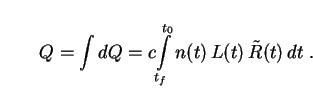 |
(12) |
Eq. (12) defines the bolometric intensity of the
extragalactic background light (EBL). This is the energy received
by us (over all wavelengths of the electromagnetic spectrum) per unit time,
per unit area, from all the galaxies which have been shining since time
tf. In principle, if we let
tf  0, we will encompass
the entire history of the Universe since the big bang. Although this
sometimes provides a useful mathematical shortcut, we will see in later
sections that it is physically more realistic to cut the integral off
at a finite formation time. The quantity Q is a measure of the amount
of light in the Universe, and Olbers' "paradox" is merely another way
of asking why it is low.
0, we will encompass
the entire history of the Universe since the big bang. Although this
sometimes provides a useful mathematical shortcut, we will see in later
sections that it is physically more realistic to cut the integral off
at a finite formation time. The quantity Q is a measure of the amount
of light in the Universe, and Olbers' "paradox" is merely another way
of asking why it is low.
While the cosmic time t is a useful independent variable for
theoretical
purposes, it is not directly observable. In studies aimed at making contact
with eventual observation it is better to work in terms of redshift
z, which is the relative shift in wavelength
 of a light signal
between the time it is emitted and observed:
of a light signal
between the time it is emitted and observed:
 |
(13) |
Differentiating, and defining Hubble's parameter
H 
 / R,
we find that
/ R,
we find that
 |
(14) |
Hence Eq. (12) is converted into an integral over z as
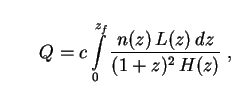 |
(15) |
where zf is the redshift of galaxy formation.
For some problems, and for this section in particular, the physics of the sources themselves are of secondary importance, and it is reasonable to take L(z) = L0 and n(z) = n0 as constants over the range of redshifts of interest. Then Eq. (15) can be written in the form
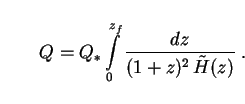 |
(16) |
Here 
 H /
H0 is the Hubble expansion rate relative to its
present value, and Q* is a constant
containing all the dimensional information:
H /
H0 is the Hubble expansion rate relative to its
present value, and Q* is a constant
containing all the dimensional information:
 |
(17) |
The quantities H0,
 0 and
Q* are fundamental to much of
what follows, and we pause briefly to discuss them here. The value of
H0 (referred to as Hubble's constant) is still
debated, and it is commonly expressed in the form
0 and
Q* are fundamental to much of
what follows, and we pause briefly to discuss them here. The value of
H0 (referred to as Hubble's constant) is still
debated, and it is commonly expressed in the form
 |
(18) |
Here 1 Gyr
 109 yr and
the uncertainties have been absorbed
into a dimensionless parameter h0 whose value is now
conservatively estimated to lie in the range
0.6
109 yr and
the uncertainties have been absorbed
into a dimensionless parameter h0 whose value is now
conservatively estimated to lie in the range
0.6  h0
h0
 0.9
(Sec. 4.2).
0.9
(Sec. 4.2).
The quantity
 0 is the
comoving luminosity density of the Universe at z = 0:
0 is the
comoving luminosity density of the Universe at z = 0:
 |
(19) |
This can be measured experimentally by counting galaxies down to some faint limiting apparent magnitude, and extrapolating to fainter ones based on assumptions about the true distribution of absolute magnitudes. A recent compilation of seven such studies over the past decade gives [2]:
 |
 |
 |
|
 |
 |
(20) |
near 4400Å in the B-band, where galaxies emit most of their light.
We will use this number throughout our review. Recent measurements by
the Two Degree Field (2dF) team suggest a slightly lower value,
 0 = (1.82 ±
0.17) × 108 h0
L
0 = (1.82 ±
0.17) × 108 h0
L Mpc-3
[4],
and this agrees with newly revised figures from the
Sloan Digital Sky Survey (SDSS):
Mpc-3
[4],
and this agrees with newly revised figures from the
Sloan Digital Sky Survey (SDSS):
 0 = (1.84 ±
0.04) × 108 h0
L
0 = (1.84 ±
0.04) × 108 h0
L Mpc-3
[5].
If the final result inferred from large-scale galaxy
surveys of this kind proves to be significantly different from that in
(20), then our EBL intensities (which are proportional to
Mpc-3
[5].
If the final result inferred from large-scale galaxy
surveys of this kind proves to be significantly different from that in
(20), then our EBL intensities (which are proportional to
 0) would go up
or down accordingly.
0) would go up
or down accordingly.
Using (18) and (20), we find that the characteristic intensity associated with the integral (16) takes the value
 |
(21) |
There are two important things to note about this quantity. First,
because the factors of h0 attached to both
 0 and
H0 cancel each other out,
Q* is independent of the uncertainty
in Hubble's constant. This is not always appreciated but was first
emphasized by Felten
[6].
Second, the value of Q*
is very small by everyday standards: more than a million times
fainter than the bolometric intensity that would be produced by a 100 W
bulb in the middle of an ordinary-size living room whose walls,
floor and ceiling have a summed surface area of 100 m2
(Qbulb = 103 erg s-1
cm-2). The smallness of Q* is
intimately related to the resolution of Olbers' paradox.
0 and
H0 cancel each other out,
Q* is independent of the uncertainty
in Hubble's constant. This is not always appreciated but was first
emphasized by Felten
[6].
Second, the value of Q*
is very small by everyday standards: more than a million times
fainter than the bolometric intensity that would be produced by a 100 W
bulb in the middle of an ordinary-size living room whose walls,
floor and ceiling have a summed surface area of 100 m2
(Qbulb = 103 erg s-1
cm-2). The smallness of Q* is
intimately related to the resolution of Olbers' paradox.
2.3. Matter, energy and expansion
The remaining unknown in Eq. (16) is the relative expansion rate
 (z), which
is obtained by solving the field equations of general
relativity. For standard FLRW models one obtains the following
differential equation:
(z), which
is obtained by solving the field equations of general
relativity. For standard FLRW models one obtains the following
differential equation:
 |
(22) |
Here
 tot
is the total density of all forms of matter-energy,
including the vacuum energy density associated with the cosmological
constant
tot
is the total density of all forms of matter-energy,
including the vacuum energy density associated with the cosmological
constant  via
via
 |
(23) |
It is convenient to define the present critical density by
 |
(24) |
We use this quantity to re-express all our densities
 in dimensionless
form,
in dimensionless
form, 

 /
/
 crit,0,
and eliminate the unknown k by evaluating
Eq. (22) at the present time so that
k c2 / (H0
R 0)2 =
crit,0,
and eliminate the unknown k by evaluating
Eq. (22) at the present time so that
k c2 / (H0
R 0)2 =
 tot,0 - 1.
Substituting this result back into (22) puts the latter into the form
tot,0 - 1.
Substituting this result back into (22) puts the latter into the form
 |
(25) |
To complete the problem we need only the form of
 tot(
tot( ), which
comes from energy conservation. Under the usual assumptions of isotropy
and homogeneity, the matter-energy content of the Universe can be modelled
by an energy-momentum tensor of the perfect fluid form
), which
comes from energy conservation. Under the usual assumptions of isotropy
and homogeneity, the matter-energy content of the Universe can be modelled
by an energy-momentum tensor of the perfect fluid form
 |
(26) |
Here density  and pressure p are related by an equation of state,
which is commonly written as
and pressure p are related by an equation of state,
which is commonly written as
 |
(27) |
Three equations of state are of particular relevance to cosmology, and will make regular appearances in the sections that follow:
 |
(28) |
The first of these is a good approximation to the early Universe, when conditions were so hot and dense that matter and radiation existed in nearly perfect thermodynamic equilibrium (the radiation era). The second has often been taken to describe the present Universe, since we know that the energy density of electromagnetic radiation now is far below that of dust-like matter. The third may be a good description of the future state of the Universe, if recent measurements of the magnitudes of high-redshift Type Ia supernovae are borne out (Sec. 4). These indicate that vacuum-like dark energy is already more important than all other contributions to the density of the Universe combined, including those from pressureless dark matter.
Assuming that energy and momentum are neither created nor destroyed, one can proceed exactly as with the galaxy current Jgµ. The conservation equation in this case reads
 |
(29) |
With the definition (26) this reduces to
 |
(30) |
which may be compared with (6) for galaxies. Eq. (30) is solved with the help of the equation of state (27) to yield
 |
(31) |
In particular, for the single-component fluids in (28):
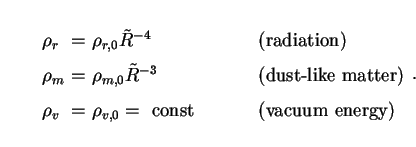 |
(32) |
These expressions will frequently prove useful in later sections. They are also applicable to cases in which several components are present, as long as these components exchange energy sufficiently slowly (relative to the expansion rate) that each is in effect conserved separately.
If the Universe contains radiation, matter and vacuum energy, so that
 tot =
(
tot =
( r
+
r
+  m
+
m
+  v)
/
v)
/  crit,
then the expansion rate (25)
can be expressed in terms of redshift z with the help of Eqs. (13)
and (32) as follows:
crit,
then the expansion rate (25)
can be expressed in terms of redshift z with the help of Eqs. (13)
and (32) as follows:
 |
(33) |
Here

 , 0
, 0


 /
/
 crit,0
=
crit,0
=  c2 / 3H02 from (23)
and (24). Eq. (33) is sometimes referred to as the
Friedmann-Lemaître equation. The radiation
(
c2 / 3H02 from (23)
and (24). Eq. (33) is sometimes referred to as the
Friedmann-Lemaître equation. The radiation
( r,0) term
can be negelected in all but the earliest stages of cosmic history
(z
r,0) term
can be negelected in all but the earliest stages of cosmic history
(z  100), since
100), since
 r,0 is
some four orders of magnitude smaller than
r,0 is
some four orders of magnitude smaller than
 m,0.
m,0.
The vacuum (
 ,0)
term in Eq. (33) is independent of redshift,
which means that its influence is not diluted with time. Any universe
with
,0)
term in Eq. (33) is independent of redshift,
which means that its influence is not diluted with time. Any universe
with  > 0 will
therefore eventually be dominated by vacuum energy.
In the limit
t
> 0 will
therefore eventually be dominated by vacuum energy.
In the limit
t 
 , in fact, the
Friedmann-Lemaître equation reduces to
, in fact, the
Friedmann-Lemaître equation reduces to

 ,0 =
(H
,0 =
(H / H0)2, where
H
/ H0)2, where
H is the limiting value of H(t) as
t
is the limiting value of H(t) as
t 
 (assuming that
this latter quantity exists; i.e. that the Universe does not recollapse).
It follows that
(assuming that
this latter quantity exists; i.e. that the Universe does not recollapse).
It follows that
 |
(34) |
If  > 0, then
we will necessarily measure
> 0, then
we will necessarily measure

 ,0 ~
1 at late times, regardless of the microphysical origin of the vacuum
energy.
,0 ~
1 at late times, regardless of the microphysical origin of the vacuum
energy.
It was common during the 1980s to work with a simplified version of
Eq. (33), in which not only the radiation term was neglected,
but the vacuum
(
 ,0)
and curvature
(
,0)
and curvature
( tot,0)
terms as well. There were four principal reasons for the popularity of this
Einstein-de Sitter (EdS) model.
First, all four terms on the right-hand side of Eq. (33) depend
differently on z, so it would seem surprising to find ourselves
living in an era when any two of them were of comparable size.
By this argument, which goes back to Dicke
[7],
it was felt that one term ought to dominate at any given time.
Second, the vacuum term was regarded with particular suspicion
for reasons to be discussed in Sec. 4.5.
Third, a period of inflation was asserted to have driven
tot,0)
terms as well. There were four principal reasons for the popularity of this
Einstein-de Sitter (EdS) model.
First, all four terms on the right-hand side of Eq. (33) depend
differently on z, so it would seem surprising to find ourselves
living in an era when any two of them were of comparable size.
By this argument, which goes back to Dicke
[7],
it was felt that one term ought to dominate at any given time.
Second, the vacuum term was regarded with particular suspicion
for reasons to be discussed in Sec. 4.5.
Third, a period of inflation was asserted to have driven
 tot(t)
to unity. (This is still widely believed, but depends on the initial
conditions preceding inflation, and does not necessarily hold in all
plausible models
[8].)
And finally, the EdS model was favoured
on grounds of simplicity. These arguments are no longer compelling today,
and the determination of
tot(t)
to unity. (This is still widely believed, but depends on the initial
conditions preceding inflation, and does not necessarily hold in all
plausible models
[8].)
And finally, the EdS model was favoured
on grounds of simplicity. These arguments are no longer compelling today,
and the determination of
 m,0 and
m,0 and

 ,0
has shifted largely back
into the empirical domain. We discuss the observational status of these
constants in more detail in Sec. 4, merely
assuming here that
radiation and matter densities are positive and not too large
(0
,0
has shifted largely back
into the empirical domain. We discuss the observational status of these
constants in more detail in Sec. 4, merely
assuming here that
radiation and matter densities are positive and not too large
(0 
 r,0
r,0
 1.5 and
0
1.5 and
0 
 m,0
m,0
 1.5),
and that vacuum energy density is neither too large nor too negative
(-0.5
1.5),
and that vacuum energy density is neither too large nor too negative
(-0.5 

 ,0
,0
 1.5).
1.5).
Eq. (16) provides us with a simple integral for the bolometric
intensity Q of the extragalactic background light in terms of the
constant Q*, Eq. (21), and the expansion rate
 (z),
Eq. (33). On dimensional grounds, we would expect Q to be
close to Q* as long as the function
(z),
Eq. (33). On dimensional grounds, we would expect Q to be
close to Q* as long as the function
 (z) is
sufficiently
well-behaved over the lifetime of the galaxies, and we will find that
this expectation is borne out in all realistic cosmological models.
(z) is
sufficiently
well-behaved over the lifetime of the galaxies, and we will find that
this expectation is borne out in all realistic cosmological models.
The question of why Q is so small (of order Q*) has historically been known as Olbers' paradox. Its significance can be appreciated when one recalls that projected area on the sky drops like distance squared, but that volume (and hence the number of galaxies) increases as roughly the distance cubed. Thus one expects to see more and more galaxies as one looks further out. Ultimately, in an infinite Universe populated uniformly by galaxies, every line of sight should end up at a galaxy and the sky should resemble a "continuous sea of immense stars, touching on one another," as Kepler put it in arguably the first statement of the problem in 1606 (see [9] for a review). Olbers himself suggested in 1823 that most of this light might be absorbed en route to us by an intergalactic medium, but this explanation does not stand up since the photons so absorbed would eventually be re-radiated and simply reach us in a different waveband. Other potential solutions, such as a non-uniform distribution of galaxies (an idea explored by Charlier and others), are at odds with observations on the largest scales. In the context of modern big-bang cosmology the darkness of the night sky can only be due to two things: the finite age of the Universe (which limits the total amount of light that has been produced) or cosmic expansion (which dilutes the intensity of intergalactic radiation, and also redshifts the light signals from distant sources).
The relative importance of the two factors continues to be a subject of controversy and confusion (see [10] for a review). In particular there is a lingering perception that general relativity "solves" Olbers' paradox chiefly because the expansion of the Universe stretches and dims the light it contains.
There is a simple way to test this supposition using the formalism we have
already laid out, and that is to "turn off" expansion by setting the
scale factor of the Universe equal to a constant value,
R(t) = R 0. Then
 = 1 and Eq. (12)
gives the bolometric intensity of the EBL as
= 1 and Eq. (12)
gives the bolometric intensity of the EBL as
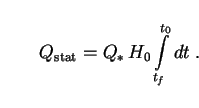 |
(35) |
Here we have taken n = n0 and L = L0 as before, and used (21) for Q*. The subscript "stat" denotes the static analog of Q; that is, the intensity that one would measure in a universe which did not expand. Eq. (35) shows that this is just the length of time for which the galaxies have been shining, measured in units of Hubble time (H0-1) and scaled by Q*.
We wish to compare (16) in the expanding Universe with
its static analog (35), while keeping all other factors
the same. In particular, if the comparison is to be meaningful, the
lifetime of the galaxies should be identical.
This is just  dt, which may -- in an expanding Universe --
be converted to an integral over redshift z by means of (14):
dt, which may -- in an expanding Universe --
be converted to an integral over redshift z by means of (14):
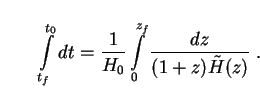 |
(36) |
In a static Universe, of course, redshift does not carry its usual physical significance. But nothing prevents us from retaining z as an integration variable. Substitution of (36) into (35) then yields
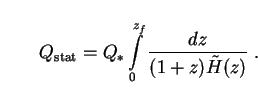 |
(37) |
We emphasize that z and
 are to be seen
here as algebraic
parameters whose usefulness lies in the fact that they ensure
consistency in age between the static and expanding pictures.
are to be seen
here as algebraic
parameters whose usefulness lies in the fact that they ensure
consistency in age between the static and expanding pictures.
Eq. (16) and its static analog (37) allow us to
isolate the relative importance of expansion versus lifetime in
determining the intensity of the EBL. The procedure is straightforward:
evaluate the ratio
Q / Qstat for all reasonable values of the
cosmological parameters
 r,0,
r,0,
 m,0 and
m,0 and

 ,
0. If
Q / Qstat << 1 over much of
this phase space, then expansion must reduce Q significantly from
what it would otherwise be in a static Universe. Conversely, values of
Q / Qstat
,
0. If
Q / Qstat << 1 over much of
this phase space, then expansion must reduce Q significantly from
what it would otherwise be in a static Universe. Conversely, values of
Q / Qstat
 1 would tell us that
expansion has little effect,
and that (as in the static case) the brightness of the night sky is
determined primarily by the length of time for which the galaxies
have been shining.
1 would tell us that
expansion has little effect,
and that (as in the static case) the brightness of the night sky is
determined primarily by the length of time for which the galaxies
have been shining.
2.5. Flat single-component models
We begin by evaluating Q / Qstat for the simplest cosmological models, those in which the Universe has one critical-density component or contains nothing at all (Table 1).
| Model Name |
 r,0 r,0 |
 m,0 m,0 |
  , 0 , 0 |
1 -
 tot,0 tot,0 |
|
| Radiation | 1 | 0 | 0 | 0 | |
| Einstein-de Sitter | 0 | 1 | 0 | 0 | |
| de Sitter | 0 | 0 | 1 | 0 | |
| Milne | 0 | 0 | 0 | 1 | |
Consider first the radiation model with a critical density of
radiation or ultra-relativistic particles
( r,0 = 1)
but
r,0 = 1)
but  m,0 =
m,0 =

 , 0 = 0.
Bolometric EBL intensity in the expanding Universe is, from (16)
, 0 = 0.
Bolometric EBL intensity in the expanding Universe is, from (16)
 |
(38) |
where x  1 +
z. The corresponding result for a static model is given
by (37) as
1 +
z. The corresponding result for a static model is given
by (37) as
 |
(39) |
Here we have chosen illustrative lower and upper limits on the redshift
of galaxy formation (zf = 3 and
 respectively). The
actual value
of this parameter has not yet been determined, although there are now
indications that zf may be as high as six. In any
case, it may be seen
that overall EBL intensity is rather insensitive to this parameter.
Increasing zf lengthens the period over which galaxies
radiate, and this increases both Q and
Qstat. The ratio
Q / Qstat, however, is given by
respectively). The
actual value
of this parameter has not yet been determined, although there are now
indications that zf may be as high as six. In any
case, it may be seen
that overall EBL intensity is rather insensitive to this parameter.
Increasing zf lengthens the period over which galaxies
radiate, and this increases both Q and
Qstat. The ratio
Q / Qstat, however, is given by
 |
(40) |
and this changes but little. We will find this to be true in general.
Consider next the Einstein-de Sitter model,
which has a critical density of dust-like matter
( m,0 = 1)
with
m,0 = 1)
with
 r,0 =
r,0 =

 , 0
= 0. Bolometric EBL intensity in the expanding
Universe is, from (16)
, 0
= 0. Bolometric EBL intensity in the expanding
Universe is, from (16)
 |
(41) |
The corresponding static result is given by (37) as
 |
(42) |
The ratio of EBL intensity in an expanding Einstein-de Sitter model to that in the equivalent static model is thus
 |
(43) |
A third simple case is the de Sitter model, which consists entirely
of vacuum energy
(
 , 0
= 1), with
, 0
= 1), with
 r,0 =
r,0 =
 m,0 =
0. Bolometric EBL
intensity in the expanding case is, from (16)
m,0 =
0. Bolometric EBL
intensity in the expanding case is, from (16)
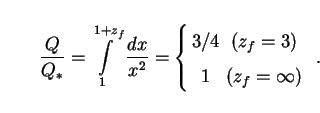 |
(44) |
Eq. (37) gives for the equivalent static case
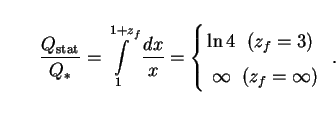 |
(45) |
The ratio of EBL intensity in an expanding de Sitter model to that in the equivalent static model is then
 |
(46) |
The de Sitter Universe is older than other models, which means it has
more time to fill up with light, so intensities are higher. In fact,
Qstat (which is proportional to the lifetime of the
galaxies) goes to infinity as
zf 
 , driving
Q / Qstat to zero in
this limit. (It is thus possible in principle to "recover Olbers'
paradox" in the de Sitter model, as noted by White and Scott
[11].)
Such a limit is however unphysical in the context of the EBL, since the
ages of galaxies and their component stars are bounded from above.
For realistic values of zf one obtains values of
Q / Qstat which
are only slightly lower than those in the radiation and matter cases.
, driving
Q / Qstat to zero in
this limit. (It is thus possible in principle to "recover Olbers'
paradox" in the de Sitter model, as noted by White and Scott
[11].)
Such a limit is however unphysical in the context of the EBL, since the
ages of galaxies and their component stars are bounded from above.
For realistic values of zf one obtains values of
Q / Qstat which
are only slightly lower than those in the radiation and matter cases.
Finally, we consider the Milne model, which is empty of all forms
of matter and energy
( r,0 =
r,0 =
 m,0 =
m,0 =

 , 0
= 0), making it an idealization
but one which has often proved useful. Bolometric EBL intensity in the
expanding case is given by (16) and turns out to be identical
to Eq. (39) for the static radiation model.
The corresponding static result, as given by (37),
turns out to be the same as Eq. (44) for the expanding de Sitter
model. The ratio of EBL intensity in an expanding Milne model to that
in the equivalent static model is then
, 0
= 0), making it an idealization
but one which has often proved useful. Bolometric EBL intensity in the
expanding case is given by (16) and turns out to be identical
to Eq. (39) for the static radiation model.
The corresponding static result, as given by (37),
turns out to be the same as Eq. (44) for the expanding de Sitter
model. The ratio of EBL intensity in an expanding Milne model to that
in the equivalent static model is then
 |
(47) |
This again lies close to previous results.
In all cases (except the
zf 
 limit of the de Sitter
model) the ratio of bolometric EBL intensities with and without expansion
lies in the range
0.4
limit of the de Sitter
model) the ratio of bolometric EBL intensities with and without expansion
lies in the range
0.4  Q /
Qstat
Q /
Qstat
 0.7.
0.7.
2.6. Curved and multi-component models
To see whether the pattern observed in the previous section holds
more generally, we expand our investigation to the wider class of open
and closed models. Eqs. (16) and (37) may be
solved analytically for these cases, if they are dominated by a single
component
[1].
We plot the results in Figs. 3,
4 and 5 for radiation-,
matter- and vacuum-dominated models respectively.
In each figure, long-dashed lines correspond to EBL intensity in
expanding models (Q / Q*) while
short-dashed ones show the
equivalent static quantities (Qstat /
Q*). The ratio of these two quantities
(Q / Qstat) is indicated by solid lines. Heavy
lines have zf = 3 while light ones are calculated for
zf =  .
.
Figs. 3 and 4 show that
while the individual intensities
Q / Q* and
Qstat / Q* do vary
significantly with
 r,0 and
r,0 and
 m,0 in
radiation- and matter-dominated models, their ratio
Q / Qstat remains nearly constant across the
whole of the phase space, staying inside the range
0.5
m,0 in
radiation- and matter-dominated models, their ratio
Q / Qstat remains nearly constant across the
whole of the phase space, staying inside the range
0.5  Q /
Qstat
Q /
Qstat
 0.7 for both models.
0.7 for both models.
Fig. 5 shows that a similar trend occurs in
vacuum-dominated models. While absolute EBL intensities
Q / Q* and
Qstat / Q*
differ from those in the radiation- and matter-dominated models,
their ratio (solid lines) is again close to flat.
The exception occurs as

 , 0
, 0
 1 (de Sitter model),
where i>Q / Qstat dips well below 0.5 for large
zf. For
1 (de Sitter model),
where i>Q / Qstat dips well below 0.5 for large
zf. For

 , 0
> 1, there is no big bang (in models with
, 0
> 1, there is no big bang (in models with
 r,0 =
r,0 =
 m,0 = 0),
and one has instead a "big bounce" (i.e. a nonzero scale factor at the
beginning of the expansionary phase). This implies a maximum possible
redshift zmax given by
m,0 = 0),
and one has instead a "big bounce" (i.e. a nonzero scale factor at the
beginning of the expansionary phase). This implies a maximum possible
redshift zmax given by
 |
(48) |
While such models are rarely considered, it is interesting to note
that the same pattern persists here, albeit with one or two wrinkles.
In light of (48), one can no longer integrate out to
arbitarily high formation redshift zf. If one wants to
integrate to at least zf, then one is limited
to vacuum densities less than

 , 0
< (1 + zf)2 / [(1 +
zf)2 - 1], or
, 0
< (1 + zf)2 / [(1 +
zf)2 - 1], or

 , 0
< 16/15 for the case zf = 3 (heavy dotted line).
More generally, for
, 0
< 16/15 for the case zf = 3 (heavy dotted line).
More generally, for

 , 0
> 1 the limiting value of EBL
intensity (shown with light lines) is reached as
zf
, 0
> 1 the limiting value of EBL
intensity (shown with light lines) is reached as
zf  zmax rather than
zf
zmax rather than
zf 
 for both expanding and
static models. Over the entire parameter space
-0.5
for both expanding and
static models. Over the entire parameter space
-0.5 

 , 0
, 0
 1.5 (except
in the immediate vicinity of
1.5 (except
in the immediate vicinity of

 , 0
= 1), Fig. 5 shows that
0.4
, 0
= 1), Fig. 5 shows that
0.4  Q /
Qstat
Q /
Qstat
 0.7 as before.
0.7 as before.
When more than one component of matter is present, analytic expressions
can be found in only a few special cases, and the ratios
Q / Q* and
Qstat / Q* must in general
be computed numerically. We show the results in
Fig. 6 for the situation which
is of most physical interest: a universe containing both dust-like matter
( m,0,
horizontal axis) and vacuum energy
(
m,0,
horizontal axis) and vacuum energy
(
 , 0,
vertical axis), with
, 0,
vertical axis), with
 r,0 = 0.
r,0 = 0.
This is a contour plot, with five bundles of equal-EBL intensity contours for the expanding Universe (labelled Q / Q* = 0.37, 0.45, 0.53, 0.61 and 0.69). The heaviest (solid) lines are calculated for zf = 5, while medium-weight (long-dashed) lines assume zf = 10 and the lightest (short-dashed) lines have zf = 50. Also shown is the boundary between big bang and bounce models (heavy solid line in top left corner), and the boundary between open and closed models (diagonal dashed line).
Fig. 6 shows that the bolometric intensity of
the EBL is only modestly sensitive to the cosmological parameters
 m,0 and
m,0 and

 , 0.
Moving from the lower right-hand corner of the phase space (Q /
Q* = 0.37)
to the upper left-hand one (Q / Q* =
0.69) changes the value of this
quantity by less than a factor of two. Increasing the redshift of
galaxy formation from zf = 5 to 10 has little effect,
and increasing it again to zf = 50 even less. This
means that, regardless of the redshift
at which galaxies actually form, essentially all of the light reaching
us from outside the Milky Way comes from galaxies at z < 5.
, 0.
Moving from the lower right-hand corner of the phase space (Q /
Q* = 0.37)
to the upper left-hand one (Q / Q* =
0.69) changes the value of this
quantity by less than a factor of two. Increasing the redshift of
galaxy formation from zf = 5 to 10 has little effect,
and increasing it again to zf = 50 even less. This
means that, regardless of the redshift
at which galaxies actually form, essentially all of the light reaching
us from outside the Milky Way comes from galaxies at z < 5.
While Fig. 6 confirms that the night sky is dark in any reasonable cosmological model, Fig. 7 shows why. It is a contour plot of Q / Qstat, the value of which varies so little across the phase space that we have restricted the range of zf-values to keep the diagram from getting too cluttered. The heavy (solid) lines are calculated for zf = 4.5, the medium-weight (long-dashed) lines for zf = 5, and the lightest (short-dashed) lines for zf = 5.5. The spread in contour values is extremely narrow, from Q / Qstat = 0.56 in the upper left-hand corner to 0.64 in the lower right-hand one -- a difference of less than 15%. Fig. 7 confirms our previous analytical results and leaves no doubt about the resolution of Olbers' paradox: the brightness of the night sky is determined to order of magnitude by the lifetime of the galaxies, and reduced by a factor of only 0.6 ± 0.1 due to the expansion of the Universe.
In this section, we inquire into the evolution of bolometric EBL intensity Q(t) with time, as specified mathematically by Eq. (12). Evaluation of this integral requires a knowledge of R(t), which is not well constrained by observation. Exact solutions are however available under the assumption that the Universe is spatially flat, as currently suggested by data on the power spectrum of fluctuations in the cosmic microwave background (Sec. 4). In this case k = 0 and (22) simplifies to
 |
(49) |
where we have taken
 =
=
 r +
r +
 m in
general and used (23) for
m in
general and used (23) for

 . If
one of these three components is dominant
at a given time, then we can make use of (32) to obtain
. If
one of these three components is dominant
at a given time, then we can make use of (32) to obtain
 |
(50) |
These differential equations are solved to give
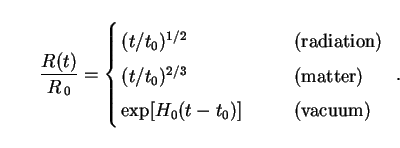 |
(51) |
We emphasize that these expressions assume (i) spatial flatness, and (ii) a single-component cosmic fluid which must have the critical density.
Putting (51) into (12), we can solve for the bolometric intensity under the assumption that the luminosity of the galaxies is constant over their lifetimes, L(t) = L0:
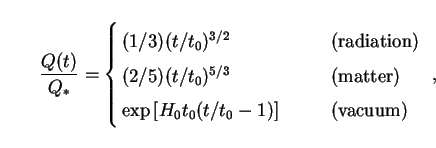 |
(52) |
where we have used (21) and assumed that tf << t0 and tf << t.
The intensity of the light reaching us from intergalactic space climbs as t 3/2 in a radiation-filled Universe, t 5/3 in a matter-dominated one, and exp(H0 t) in one which contains only vacuum energy. This happens because the horizon of the Universe expands to encompass more and more galaxies, and hence more photons. Clearly it does so at a rate which more than compensates for the dilution and redshifting of existing photons due to expansion. Suppose for argument's sake that this state of affairs could continue indefinitely. How long would it take for the night sky to become as bright as, say, the interior of a typical living-room containing a single 100 W bulb and a summed surface area of 100 m2 (Qbulb = 1000 erg cm-2 s-1)?
The required increase of Q(t) over Q* (= 2.5 × 10-4 erg cm-2 s-1) is 4 million times. Eq. (52) then implies that
 |
(53) |
where we have taken H0 t0
 1 and
t0
1 and
t0  14 Gyr, as suggested by the observational data
(Sec. 4).
The last of the numbers in (53) is particularly intriguing.
In a vacuum-dominated universe in which the luminosity of the galaxies
could be kept constant indefinitely, the night sky would fill up with light
over timescales of the same order as the theoretical hydrogen-burning
lifetimes of the longest-lived stars.
Of course, the luminosity of galaxies cannot stay constant
over these timescales, because most of their light comes from much
more massive stars which burn themselves out after tens of Gyr or less.
14 Gyr, as suggested by the observational data
(Sec. 4).
The last of the numbers in (53) is particularly intriguing.
In a vacuum-dominated universe in which the luminosity of the galaxies
could be kept constant indefinitely, the night sky would fill up with light
over timescales of the same order as the theoretical hydrogen-burning
lifetimes of the longest-lived stars.
Of course, the luminosity of galaxies cannot stay constant
over these timescales, because most of their light comes from much
more massive stars which burn themselves out after tens of Gyr or less.
To check whether the situation just described is perhaps an artefact of
the empty de Sitter universe, we require an expression for
R(t) in models
with both dust-like matter and vacuum energy. An analytic solution does
exist for such models, if they are flat (i.e.

 ,0 =
1 -
,0 =
1 -  m,0).
It reads
[1]:
m,0).
It reads
[1]:
 |
(54) |
This formula receives surprisingly little attention, given the importance of vacuum-dominated models in modern cosmology. Differentiation with respect to time gives the Hubble expansion rate:
 |
(55) |
This goes over to

 ,
01/2 as
t
,
01/2 as
t 
 , a result which
(as noted in Sec. 2.3) holds quite generally for
models with
, a result which
(as noted in Sec. 2.3) holds quite generally for
models with  > 0.
Alternatively, setting
> 0.
Alternatively, setting
 = (1 +
z)-1 in (54)
gives the age of the Universe at a redshift z:
= (1 +
z)-1 in (54)
gives the age of the Universe at a redshift z:
 |
(56) |
Setting z = 0 in this equation gives the present age of the
Universe (t0).
Thus a model with (say)
 m,0 = 0.3
and
m,0 = 0.3
and 
 , 0
= 0.7 has an age of t0 =
0.96H0-1 or, using (18),
t0 = 9.5h0-1 Gyr.
Alternatively, in the limit
, 0
= 0.7 has an age of t0 =
0.96H0-1 or, using (18),
t0 = 9.5h0-1 Gyr.
Alternatively, in the limit
 m,0
m,0
 1, Eq. (56)
gives back the standard result for the age of an EdS Universe,
t0 = 2 / (3H0) =
6.5h0-1 Gyr.
1, Eq. (56)
gives back the standard result for the age of an EdS Universe,
t0 = 2 / (3H0) =
6.5h0-1 Gyr.
Putting (54) into Eq. (12) with L(t) =
L0 = constant,
and integrating over time, we obtain the plots of bolometric EBL intensity
shown in Fig. 8. This diagram shows that the
specter of a
rapidly-brightening Universe does not occur only in the pure de Sitter
model (short-dashed line). A model with an admixture of dust-like matter
and vacuum energy such that
 m,0 = 0.3
and
m,0 = 0.3
and 
 , 0
= 0.7, for instance,
takes only slightly longer (280 Gyr) to attain the "living-room" intensity
of Qbulb = 1000 erg cm-2 s-1.
, 0
= 0.7, for instance,
takes only slightly longer (280 Gyr) to attain the "living-room" intensity
of Qbulb = 1000 erg cm-2 s-1.
In theory then, it might be thought that our remote descendants could live under skies perpetually ablaze with the light of distant galaxies, in which the rising and setting of their home suns would barely be noticed. This will not happen in practice, of course, because galaxy luminosities change with time as their brightest stars burn out. The lifetime of the galaxies is critical, in other words, not only in the sense of a finite past, but a finite future. A proper assessment of this requires that we move from considerations of background cosmology to the astrophysics of the sources themselves.